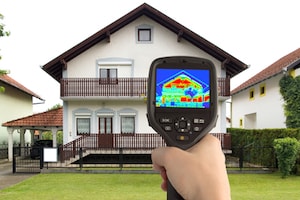Home Inspection: Infrared Thermography

Energy Loss
An infrared thermography inspection has the power to detect areas in your home that are causing your energy consumption to be higher than it needs to be. Specific areas where energy loss can be detected are broken seals in double-paned windows, air-conditioner leaks, damaged heating systems, any structural problems, heat loss in walls, windows, ceilings, floors, doors, and anywhere else in your home that could be allowing energy to escape.
Electrical Errors
This is one area that can be quite dangerous if not addressed. Remember that most electrical problems increase the risk of fire. The infrared thermography inspection can see overloaded and undersized circuits, overheated electrical equipment, electrical faults, and circuit breakers that need to be replaced ASAP. Electrical issues can be costly if not taken care of promptly. This is an important inspection to include before purchasing a home to determine if you are getting quality electric wiring within the walls.
Moisture
Infrared thermography inspections can detect moisture problems before they get too far out of hand. If there has been any leaking or moisture penetrating an area of your home, the film and still image will catch it. Some issues that could lead to moisture issues are damaged and wet insulation, plumbing leaks, roof leaks, and foundation leaks. Identifying these areas as soon as possible can reduce the risk of mold build-up.
Before you schedule your infrared thermography inspection, there are a few tips and tricks to make sure your inspection reads as accurately as possible. Move furniture away from exterior walls and remove drapes. To get the most accurate inspection, schedule it for when there is a large temperature difference between indoors and outdoors. In the northern states, the winter is best while you have the heat on, and in southern states, summer is best, while you have the air conditioning on. Save on energy and maintain the safety of your home by setting up your infrared thermography inspection today with Inspect-It 1st®.
